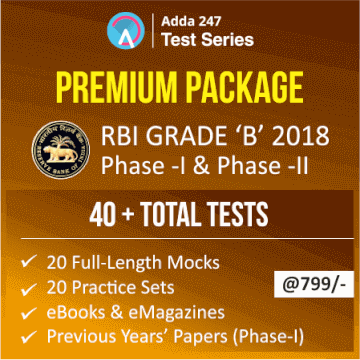Dear Aspirants,
Reasoning Questions for SBI PO/Clerk Mains 2018
Complexity of questions in Reasoning Ability for Banking and Insurance exams is increasing tremendously and one needs to put his nose on the grindstone while preparing for this section. Cracking questions of the Mains level will not be an easy task if one do not get into a habit of continuous practice of latest pattern based questions. And, to let you practice with the best of the latest pattern questions, here is the Adda247 Reasoning Quiz based on the latest pattern for SBI PO and Clerk Mains Exam. Not only this, these quizzes will also prove propitious for the upcoming Bank of Baroda Exam. Now, pull up your socks, it’s time to practice till perfection.
Directions (1-3): Study the information carefully and answer the questions given below.
Q is the wife of P. P is the grandfather of R. Q has only one child(son) who is married to T’s child. T has only two children one son and one daughter. X is grandson of T. S is brother in law of son of T. U and V are children of T. W is married to the son of T. X is nephew of U and he is W’s child. Only consider given persons.
Q1. If R is married to Y than how is Y related to S?
(a) Son
(b) Daughter
(c) Son in law
(d) Daughter in law
(e) CND
Q2. How is S related to T?
(a) Son
(b) Daughter
(c) Son in law
(d) Daughter in law
(e) Husband
Q3. How is Q related to R?
(a) Grandfather
(b) Grandmother
(c) Uncle
(d) Aunt
(e) Either (c) or (d)
Direction (4-6): In the following questions, the symbols #, &, @, * , $, % and © are used with the following meanings as illustrated below. Study the following information and answer the given questions:
P#Q – P is the son of Q.
P@Q – Q is the child of P.
P©Q – P is the parent of Q.
P$Q – P is brother than Q.
P*Q- P is the husband of Q.
P&Q- Q is the daughter-in-law of P.
P%Q- P is the wife of Q.
Q4. If A & D % B &G %E, F # B then how is A related to E?
(a)Grandfather
(b)Grandson
(c)Daughter
(d)Grandmother
(e) CND
Q5. If A*B&C@D#E, the age of E is 25 years and age of C is 20 years, then what may be the probable age of B?
(a)17 years
(b)15 years
(c)23 years
(d)45 years
(e)12 years
Q6. If A & D % B &G %E, F # B then how is G related to B ?
(a) father in law
(b) son in law
(c) Daughter in law
(d) Wife
(e) None of these
Directions (7-8): Read the following information and answer the following questions
A + B means ‘A is the father of B’
A- B means ‘A is the husband of B’
A*B means ‘A is the sister of B’
A%B means ‘A is the brother of B’
A@B means ‘A is the mother of B’
Q7. What should be placed in place of question mark in ‘A * D ? P – R ‘so that R becomes daughter in law of D?
(a) @
(b) +
(c) –
(d) %
(e) Both @ and +
Q8. How many female members are there in the expression A + B – C * D @ E?
(a) One
(b) Two
(c) Three
(d) Four
(e) Can’t be determined
Q9. Five persons namely A, B, C, D and E are going to the school on different days of the week, starting from Tuesday to Saturday. Two persons are going between C and B. C is going before Thursday. D is going to the school immediate after E. A is not going on Saturday. Then who among the following person is going to school on Wednesday?
(a) B
(b) C
(c) D
(d) E
(e) A
Q10. A is the mother of Q. J is the brother of Q. R is the father of J. J is the father of S. If it is given that Q is daughter of A, then what is the relation of Q with respect to S?
(a) Aunt
(b) Mother-in-law
(c) Mother
(d) Uncle
(e) Grand father
Q11. A is 27th from the right end and B is 22nd from the left end of a row. If they interchange their positions, then A becomes 22nd from the left end. If all are facing same direction then how many persons are sitting in the row?
(a) 48
(b) 50
(c) 49
(d) CND
(e) None of these
Directions (12-13): Study the following information and answer the given questions:
There are six family members A, B, C, D, E and F and all of them are of different age. D is older than only one person. E is older than B and D but not as old as A. B is not the youngest. C is oldest in the family. The age of A is 35 year and the age of person who is third youngest is 30 years.
Q12. Who is second oldest in the family?
(a) A
(b) B
(c) D
(d) E
(e) C
Q13. What is the possible age of E?
(a) 42 years
(b) 20 years
(c) 55 years
(d) 19 years
(e) 32 years
Directions (14-15): Study the following information and answer the given questions:
Six boxes A, B, C, D, E, F of different colours are placed one above another. Also, each box has different number of toffees. No two boxes has same number of toffees. Only two boxes are placed in between B and Green box. No box is placed above B. Box D is placed immediately above Blue box. Only Red box is placed in between Green box and A. Only one box is placed between Red and Blue box. Only one box is placed in between D and E. Only one box is placed between Orange box and C. Box C is not of Red colour. Box E has more number of toffees than 8 while box C has more number of toffees than 20. Box D has 21 toffees. The box which has lowest and 2nd lowest number of toffees has 10 and 12 toffees respectively. Box A, C, D and F has odd number of toffees. A has more number of toffees than B but not more than D. The difference in the number of toffees in box F and E is 7. The box which has highest number of toffees has 8 more toffees than box F. Total number of toffees in box B and A is 31.
Q14. How many number of toffees does Blue box have?
(a) 42
(b) 20
(c) 25
(d) 19
(e) 32
Q15. Which box has least number of toffees?
(a) A
(b) B
(c) C
(d) D
(e) E





 Reasoning Quiz For Bank Foundation 2024 ...
Reasoning Quiz For Bank Foundation 2024 ...
 Reasoning Quiz For Bank Foundation 2024 ...
Reasoning Quiz For Bank Foundation 2024 ...



